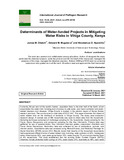| dc.description.abstract | Currently, 85 per cent of the world’s human population lives in the drier half of the Earth, which exacerbates the water risks including lack of access to safe water, poor basic sanitation and water-related disasters and diseases. Vihiga County is located in the western region of Kenya (former western province). The county covers a total area of 531.0 Km2. This paper examines the impact of water related risks on the livelihood of residents in Vihiga County. The study used evaluation research design. A sample size of 384 households was used to obtain data from the households. Sampling technique comprised of multistage sampling for the households, Quota sampling for the Focus Group Discussions and purposive sampling for the Key Informants. Primary data was gathered by use of questionnaires, Key Informant Interview guides, observation checklists and Focus Group Discussions. Secondary data was collected by use of publications, journals, and internet access. Quantitative data was analysed using Microsoft excel, and Statistical Package for Social Scientists (SPSS) version 20.0. Results reveal that majority of the household respondents had experienced different forms of water related risks including, water pollution at 42%, inadequate water infrastructure 32%, poor water governance 10%, water scarcity 7% and environmental flows at 4% respectively. The study established that the existing Water Funded Projects (WFPs) initiatives include protected water springs at 31%, water kiosks 21%, boreholes at 18%, open wells 14 %, rain water harvesting at 12% while 4% of household respondents had piped water. The results (X25, 0.05=69.76; p-value=0.000) indicating that Water Funded Projects (WFPs) initiatives have positively influenced reduction in water related risks. | en_US |

